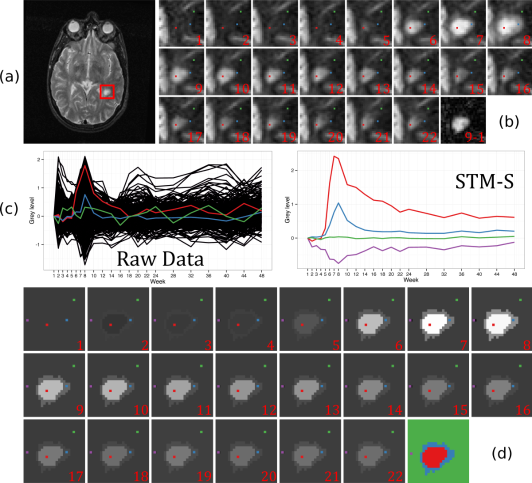Time series clustering
Collaboration with Image and Models team in Creatis Laboratory in Lyon
Due to the dramatic increase of longitudinal acquisitions in the past decades such as video sequences, global positioning system (GPS) tracking or medical follow-up, many applications for time-series data mining have been developed. Nevertheless, reliable prior knowledge about the data is not always available to guide or train a classification procedure. Therefore, unsupervised time-series data mining has become highly relevant with the aim to automatically detect and identify similar temporal patterns between time-series.
In this respect, our aim is to propose new image processing methods and to apply them to follow-up images [1,2] acquired in various application domains such as : neurology, video , satellite or photoacoustic imaging. However, we first placed a particular emphasis on the study of multiple sclerosis [3], whose genetics and environmental factors triggering and governing the disease evolution, as well as the occurrence and evolution of individual lesions are still mostly unknown and under intense investigation.
To this end, we have proposed a new spatio-temporal filtering scheme based on the mean-shift procedure, a state of the art approach in the field of image processing, which allows to cluster multivariate spatio-temporal data. We also have proposed a hierarchical time-series clustering algorithm based on the dynamic time warping measure that identifies similar but asynchronous temporal patterns. A result obtained with the spatio-temporal mean-shift adaptation (STM-S) in the study on multiple sclerosis is presented below :

(a) 2D section of a 3D T2 MRI acquisition and region of interest (ROI) identification. (b) Multiple sclerosis lesion evolution in the ROI over 22 time-points. The image 9-1 shows the subtraction image between time-points 9 and 1. (c) Left : intensity temporal evolution of all the ROI voxels, the three colored curves represent the intensity evolution of the landmark voxels in (b). Right : intensity temporal evolution of all the ROI voxels obtained with the STM-S clustering method. (d) Voxel intensities after clustering. Bottom right-hand corner : Obtained clusters, the colors correspond to the cluster evolution in (c)-Right.
S. Mure, T. Grenier, D.S. Meier, C.R.G. Guttmann, and H. Benoit-Cattin, Unsupervised spatio-temporal filtering of image sequences. a mean-shift specification, Pattern Recognition Letters, vol. 68, Part 1, pp. 48–55, 2015.
S. Mure, T. Grenier, C.R.G. Guttmann, H. Benoit-Cattin, Unsupervised time-series clustering of distorted and asynchronous temporal patterns, 2016 IEEE International Conference on Acoustics, Speech and Signal Processing (ICASSP), Shanghai, 2016, pp. 1263-1267.
S. Mure, T. Grenier, C.R.G. Guttmann, F. Cotton, H. Benoit-Cattin, Classification of multiple sclerosis lesion evolution patterns. A study based on unsupervised clustering of asynchronous time-series, 2016 IEEE 13th International Symposium on Biomedical Imaging (ISBI), Prague, 2016, pp. 1315-1319.
